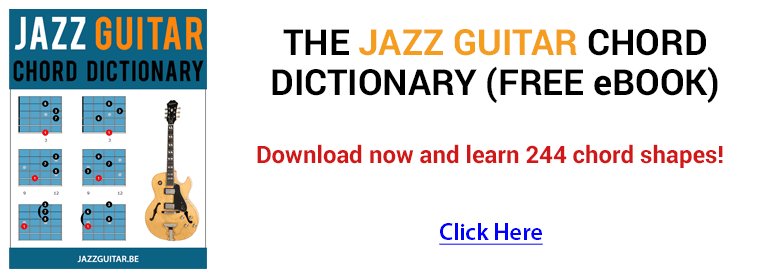-
bVmin upper structure triad.
inversions the triad on strings 1,2,3 (try on the other strings, really hard not too practical)... you also can get something with open D and B strings too but I digress...
root pos Ab min:
xx10-13-12-11 (you're omitting the 3rd)
1st inv Ab min:
x-3-4-4-4-4 (as mentioned previously)
2nd inv Ab min (best sound IMO, but hard to finger bc you need to do a cross barre)
x-9-10-8-9-7
fingering: x-2-4-1-3-1
To the OP: to play the original chord mentioned earlier in the thread just concentrate on keeping some bend in the last joint of the 3rd finger (try playing with the tip as much as is comfortable).
-
05-29-2018 08:48 PM
-
Come on Joe. We're movers not hitters.
Ebm6o.
Don't take the changes literally; they are changing.
-
Alan! what are you doing here? It was just one mickey baker chord, I swear!
-
And what's more the book provides the fingering. And given it a fancy title.
-
 Originally Posted by joe2758
Originally Posted by joe2758
That Mickey Baker leads to harder stuff Joe. Now go to your room.
-
The question is:
Why did Mickey Baker put in a picture of an Ab7#9 and call it D13b9b5?
-
The whole “vibe” of the book, to me, comes off as “just do it.” He barely explains anything (I know, he does some.) My point is I think it was “let’s call it a D chord so they know the function— they’ll learn about tri-tone subs later.”
-
not how i would have approached it, but he’s a cushtie geeza either way.
-
I haven't looked through this entire thread yet, so I'm not sure how many of these have already been shared... but here's a few I'd jump to
X3X444
XX6547
8X989X
XX10.897
XX10.13.12.11
They're all rootless... if you want to hear them as they would sound in an ensemble, you can sing a low D, loop it with a pedal, or move any of these up a whole step and play them against the low E string to transpose it to an E13b9b5 and hear what it would sound like against a bass player. And really, with a little playfulness, some of these can actually handle squeezing the root in there as well. But they'll make your life more difficult... and if you're playing with a bass player... it's really not necessary.
-
For the case where some altered version of the V chord followed by the root (maj) is a good ending, this fingering from MB and then just move fingers 1-2-3 down one fret to make a nice/full Imaj7 is a nice ending for cases where that works.
dave
-
I'm a newbie too and trying to go thru the MB book, chord #6 was a booger but finally able to 'grab it', it's #7 that I wrote a big X thru!! (I'm sure there will be lots more to scratch out!} My hands are to small for those long-reach pinkie finger chords, should I just give up now?
Has anybody ever worked all the way thru the first MB book??
Thanks,
Dick C.
-
Don't give up yet. I doubt that your hands are smaller than mine. Of course I could be thinking that my hands are smaller than they actually are. Maybe a photo next to a ruler would be a way to show the actual size.
 Originally Posted by goinbaroke
Originally Posted by goinbaroke
Anyway, you've got Mickey's infamous chord #6 down so you're making progress. I think it's worth forcing yourself to be able to play #7. You're going to have to push yourself out of your comfort zone. Start high up the neck where the frets are closer together and gradually work your way down towards the 1st fret. I don't mean in one practice session. This might take some time. But just 2-3 minutes a day will probably get you there faster than you think.
There are chord shapes that many people can easily play that are physically impossible for me. However, chord #7 isn't one of them and you can probably do it too. It's important that you don't barre with your index finger. You only need to finger the 6th string with your index. The 4th string is muted by your ring finger kinda laying over it.
I hope this helps. Don't give up. Look at stuff like this as a challenge.
I worked thru the 1st half of Baker's book. I'll admit that I didn't do it the way he tells you to. I'm now starting over and am working on both halves at the same time. The 2nd half is forcing me to read standard notation which is something I've put off for far too long.Last edited by Jack E Blue; 06-04-2018 at 10:38 PM.
-
Thanks Jack, I'll take your advice and keep trying #7, I'm 79 and so fingers are a little slower now. I'm never going to be in a band, just do this to keep my mind going!
I agree on the working in first and second halves of the book, I want more than accompanying, I want to do single-string stuff too, and not being a note reader I convert all to tabs so I can play some of the old tunes: Misty, Satin Doll, Shadow of your Smile, Autumn Leaves, etc.
Thanks again for your advice,
Dick C. (GoinBaroke)
-
Wow, Dick, 79 years old and still pursuing new and challenging things to learn. That is not only admirable, it's inspirational. I hope I'm still able to do this when I'm 79. Right now I'm just a 66 year old teenager.

Keep plugging away. Segovia, Les Paul, Bucky Pizzarelli and others played into their 90's.
-
Thanks Jack, age is just a number!
Practiced on the #7 chord yesterday, started on the 7th fret, did okay so far!

-
BTW, for those that don't know you can always google a chord and go to the google images link to see lots of different variations of that chord often with useful sublinks; in this case, D13b5b9, there is one for Mickey Baker. A lot quicker than looking at a book or a dedicated chord web site/app. For more ambiguous searches do something like "g guitar chord".
-
Thanks ZDUB, never thought to do that!
-
For those of you ready to move on...(always warm up before attempting the final chord)
-
That's a Johnny Smith chord! LOL

-
Except the chord's Ab, Bb, C, D, Eb. F......
 Originally Posted by rpjazzguitar
Originally Posted by rpjazzguitar
I'm not going to spoon feed everyone, but a top tip from Barry Galbraith no less, never overlook the nose.
-
Right. Sorry. I missed the key sig.
 Originally Posted by dot75
Originally Posted by dot75
-
Hey, I'm new to this forum and I also put some thoughts in the D13b5b9 chord in the past since I love playing it. Mickey Bakers books are great and still hold up, but there are some little mistakes in it. The D13b5b9 really is a D7b9 (or #9 if you wish) and represents the half/whole-step diminished scale (Root, b9 #9, 3, #11, 5, 13, 7). Because of this the name D13b5b9 is not quite right since the b5 indicates that there is no fifth (but there is). The b5 really is a #11.
V7 b9 chords sounds best when they resolute down a fifth. This is the reason why the D13b5b9 chord (which is a D7b9) sounds so great when followed by the Gmaj7.
P.S.
Please excuse my english. I only learned it by watching The Wire when I was 16.
-
You're probably right, but those equations are beyond me! I love the chord too, and also the Gma7th after it, although I can only grab it down to the 5th fret!
P.S.: Your English is better than mine!!
-
But it's not really "FROM" half/whole-step diminished. It's possible to associated with it, ....or it could be altered scale. It's certainly true that a lot of flat five and sharp five representations in chord symbols are messed up.
 Originally Posted by Mad Cat
Originally Posted by Mad Cat
Anyway, the BIGGEST problem with this chord , here in 2018, is the outdated labeling of it as a D chord in the first place. Modern players or composers would name it from an Ab root. It's just an old fashion and naming convention.
Sent from my SM-J727P using Tapatalk
-
I always use it as a V7, so the name is correct for how I use it.
 Originally Posted by matt.guitarteacher
Originally Posted by matt.guitarteacher




 Reply With Quote
Reply With Quote



$8500 - 2010 Moffa Maestro Virtuoso Archtop Black...
Today, 03:35 AM in For Sale